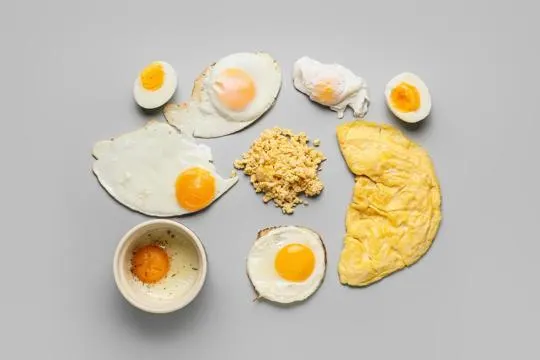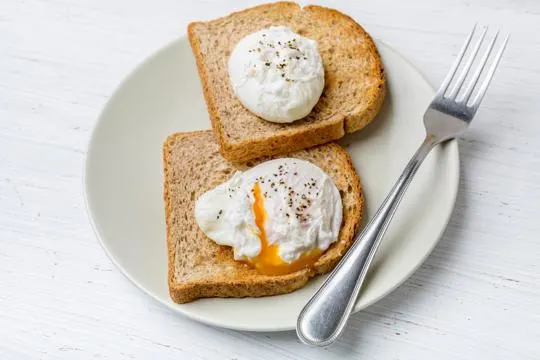Summary of key points
The main difference between basted eggs and poached eggs is in the cooking method. Basted eggs are cooked in a frying pan with a small amount of water or broth, while poached eggs are gently dropped into boiling water.
The end result is similar – a runny yolk surrounded by cooked egg whites – but the texture can vary slightly. Basted eggs tend to have a slightly firmer yolk, while poached eggs have a softer, more delicate yolk.
Additionally, basted eggs can be easily flavored with herbs and spices during the cooking process, while poached eggs are typically served plain or seasoned after cooking.
In the breakfast battle, two egg styles reign supreme. Basted eggs and poached eggs. What sets them apart?
Eggs. We crack them, we cook them, we love them. Yet, how much do we really know about the different ways to prepare them? Today, we’re cracking the case on basted versus poached eggs.
Our mornings often start with this dilemma. A skillet sizzles; water simmers. It’s not just about how they taste. It’s about how we make them dance to our morning tune.
I’ve accidentally made basted eggs aiming for poached. That was a surprise. They both share the spotlight in our breakfast but play different roles.
What are Basted Eggs?

Prepare basted eggs to delight your taste-buds.
Fry them in a skillet, with hot butter or oil spooned over.
This creates a moist atmosphere, so they cook evenly and don’t dry out.
Flavorful and tender, they’re the perfect breakfast treat.
Timing and technique are key.
Maintain the heat, whites set and yolks remain runny.
Enjoy them solo, or add to sandwiches, salads or toast.
Make mornings memorable with basted eggs – their rich taste and texture will take your breakfast to new heights.
Simple yet extraordinary, why not indulge yourself?
What are Poached Eggs?

Poached eggs are a classic dish. They are cooked in simmering water, creating a tender white and runny yolk.
Crack the egg into a shallow dish of hot water and let it cook until the white is set but the yolk remains soft.
Their simplicity and versatility make them special.
Enjoy them on their own or top off dishes like salads, toast, or Eggs Benedict.
When cooked, the whites should be firm and tender, while the yolk should flow when pierced.
No added fats like oil or butter, that makes them a healthy option.
Plus, without direct heat contact, poached eggs retain more of their natural nutrients.
For perfection, choose fresh eggs. The fresher, the better.
Use vinegar in the cooking water – it helps coagulate the proteins in the egg whites.
This stops them from spreading.
Differences Between Basted Eggs and Poached Eggs

Basted and poached eggs look similar, yet they have unique qualities.
Cooking Method
Cooking can impact the end result of a dish.
Two popular egg-cooking methods are basting and poaching.
Basting involves frying eggs in oil/butter and spooning hot fat over them until done.
Poaching is gentler – you simmer eggs in water, adding vinegar to help whites coagulate faster.
Then carefully slide cracked eggs into the water.
Basting in fat gives eggs a richer flavor and a tender texture.
Poaching creates a delicate egg with cooked whites and a soft, runny yolk.
Basted eggs often have crispy edges, while poached eggs are silky.
Which to use depends on preference and desired flavors.
Texture and Appearance
Basted eggs and poached eggs have distinct features that set them apart.
Basted eggs possess a soft texture and a visually pleasing look.
Their whites are cooked until just set, giving a smooth exterior. The yolk stays runny and velvety.
On the other hand, poaching creates a firm and springy texture.
The white of the egg fully encircles the yolk, making a neat shape.
Basted eggs have a more tender texture compared to poached eggs.
Folks who like pillowy whites with a creamy yolk prefer basted eggs.
Poached eggs suit those who go for a firmer texture and a cooked yolk.
Choosing between the two comes down to personal taste.
Whether you like basted eggs’ softness or poached eggs’ firmness, both offer delicious dishes for breakfast lovers.
Flavor Profile
Basted eggs and poached eggs are distinct in flavor profiles.
Basted eggs are known for their buttery flavor.
This comes from melting butter in a skillet and cooking briefly.
This leaves the yolk soft and runny.
Poached eggs are simmered in water.
This gives them a silky texture, with a velvety yolk.
The difference between these two methods lies in fat.
Basted eggs have butter, which infuses the egg with richness and a nutty flavor.
Poached eggs have no fat, so their natural flavor stands out.
The two methods also differ in texture.
Basted eggs are crunchy outside, with a gooey center.
Poached eggs have a delicate consistency, with soft whites and a smooth yolk.
Basted eggs have more customization options for flavor. Chefs can add herbs or spices.
Poached eggs are pure, without additional enhancements.
Preparation Time
Think about how long it takes to cook eggs. It can depend on the method you use.
Knowing the differences helps you to choose the one that works for you.
To start, crack an egg into a hot non-stick pan.
- Cover it with a lid and cook 2-3 minutes.
- The whites will be set, but the yolk runny.
- This is a quick way to make eggs.
- Get a pan of water to a gentle simmer.
- Stir to make a whirlpool.
- Put an egg in a small bowl and slide it in.
- Poach 3-4 minutes till ready.
- This needs more patience but the eggs will be delicate.
Think about texture. Basted eggs are firmer. Poached eggs are soft.
Which do you like better?
Both methods take similar time. The difference is in the technique.
Pick based on texture and how it fits your dish.
Similarities Between Basted Eggs and Poached Eggs

Basted eggs and poached eggs are similar in cooking method and texture.
Both involve cooking the egg without its shell, allowing the whites to set while keeping the yolk slightly runny.
The result is a delicate, soft egg with a delicious yolk.
Both techniques require careful timing and temperature.
Poached eggs are submerged directly into the water.
Basted eggs are cooked by spooning hot butter or oil over them.
This adds flavor and creates a crispy texture at the edges.
When cooked, the whites set yet remain tender.
The yolks stay creamy and runny.
Basting adds butter or oil which enhances the flavor.
This contrasts with the softness of the egg.
In conclusion, basted and poached eggs have differences but are similar in texture and flavor.
Whether you baste or poach, the result is a luxurious egg that can make any meal special.
Creative Uses for Basted and Poached Eggs
Unlock basted and poached eggs’ creative potential.
Let’s explore the possibilities these cooking methods have to offer.
Unfasten your apron and delve into a world of culinary delights.
Start with breakfast.
Think outside the box and put these eggs in a sandwich.
Ciabatta bread, melted cheese, bacon, avocado slices, and a basted egg – you won’t regret it.
Enjoy an explosion of flavors.
Salads, bowls and Benedicts can all be improved with poached eggs.
What about smoked salmon and homemade hollandaise on English muffins? A luxurious brunch option that’ll impress everyone.
Last but not least: pasta.
Carbonara sauce and an egg that oozes its velvety yolk when touched.
An exquisite dish, guaranteed.
So, what are you waiting for? Experiment with basted and poached eggs in the kitchen and get creative.
Basted Eggs vs Poached Eggs: Which is Preferable?
Basted eggs and poached eggs are two popular breakfast options.
But which one is best? Let’s find out.
For basted eggs, they’re made by cracking an egg into a hot pan with butter or oil.
The cook then spoonfuls the hot fat over the egg until ready.
This creates a tender egg with a glossy look.
Poached eggs are created by simmering an egg in water without any fat.
This takes finesse, as the egg white should wrap the yolk without losing texture.
The end result is a velvety egg. Both offer different textures and flavors.
Basted eggs have a richer taste due to the fat used.
They also have a firmer white than poached eggs.
Poached eggs offer a lighter flavor and a smooth texture.
Which one is better? That depends on preference. Basted eggs are creamy and rich.
Poached eggs are light and melt in your mouth. Both provide unique characteristics.
Conclusion
All in all, basted eggs and poached eggs are both simple to make applications of breakfast that can spice up any morning.
While the more traditional methodology behind poaching might necessitate some creativity and patience, the easy execution of basting can both save time and cost without sacrificing flavor.
There’s a reason why these two items remain staples of breakfast buffets and menus: they’re easy to make, offer variety, and a great way to start the day with.
It really all comes down to preference; whichever option you choose is sure to be delicious.
For newbies or even adventurous cooks out there looking for an alternative spin on eggs, look no further than this dynamic duo: poached and basted eggs.

Leave a comment